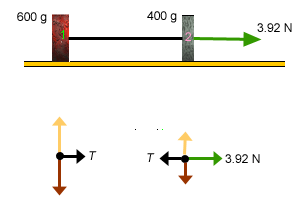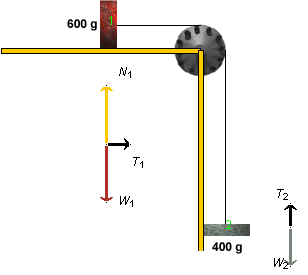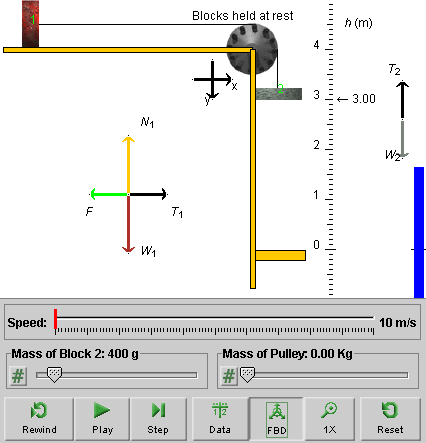Advanced Lesson - Fletcher's Trolley
The applet simulates the motion of two blocks connected by a
string that is guided over a pulley.
Preamble
This lesson will give insight into the physics concepts of
force, especially tension, free-body diagrams, and Newton's
second law of motion. The system studied involves objects
moving with constant accelerations, and the lesson will
review concepts related to motion with constant acceleration.
The applet should be open. The step-by-step instructions in
this lesson are to be carried out in the applet. You may need
to toggle back and forth between instructions and applet if
your screen space is limited. You should be prepared to do
calculations to verify the numbers that are generated by the
applet.
Contents
The Easy Way to Calculate the Acceleration
-
Introduction of a System Dynamically Equivalent to
Fletcher's Trolley
Before working through this section, you should have worked
through the section "Acceleration Calculated from the Masses
of the Blocks" in the Lesson available above. Here, the
acceleration will be calculated once more, by a quicker
method. However, this method must first be justified, and
this justification involves a comparison with the method
used in the section from the other Lesson.
As in the Lesson, let us assume the pulley in Fletcher's
Trolley to be massless. Let us consider another system that
looks somewhat different from Fletcher's Trolley, the system
of two horizontally moving blocks shown in Figure 1
below. Figure 1 also shows he free-body diagrams for the two
blocks in this new system.

Figure 1
The system consists of two blocks with the same masses as
in Fletcher's Trolley, 600 g and 400 g. The blocks are
connected by a massless, inextensible string and can
slide without friction on a horizontal table. A force of
magnitude 3.92 N is acting on block 2 to the right. This
force has the same magnitude as the force of gravity that
is acting on block 2 in the downward direction in
Fletcher's Trolley.
Compare the free-body diagrams for the horizontally moving
system to those for Fletcher's Trolley, which are shown in
Figure 2 below. Draw both sets of free-body diagrams side
by side in your Notebook, for practice and to have them there
for later reference.

Figure 2
The horizontally moving system is dynamically equivalent to
Fletcher's Trolley, because Newton's second law applied to
the two horizontally moving blocks leads to the same
equations that apply to Fletcher's trolley, namely, Eqs. (3)
and (4) from the Lesson. They will be quoted as (L3) and
(L4) here:
Block 1 (x-direction):
T =
0.6a (L3)
Block 2 (y-direction):
W2 - T = 0.4a.
(L4)
Remember that the weight W2 of Block 2 is
equal to 0.4g = 0.4×9.8 = 3.92 N. The magnitude
of the horizontal force applied on Block 2 in the
horizontally moving system must be chosen to be equal to
W2.
To derive Eqs. (L3) and (L4) for the horizontally moving
system, look at the free-body diagrams for this system and
and those for Fletcher's Trolley in your Notebook. Pay
particular attention to the forces on the two blocks that
are directed along the lines of motion of the blocks.
As far as the forces along the lines of motion of the blocks
are concerned, they look identical, except that the diagram
for Block 2 in the horizontal system is turned by
900 relative to that in Fletcher's Trolley. The
free-body diagram for Block 2 in the horizontally moving
system also contains two vertical forces, indicated by
yellow and maroon arrows, that are absent in the free-body
diagram for Block 2 in Fletcher's Trolley. However, these
forces are perpendicular to the line of motion of the blocks
and have no effect on the acceleration and tension, the two
quantities that we are interested in here.
If the same sets of forces are acting on the two pairs of
blocks along the lines of motion of the blocks with the same
values for the masses and applied forces, Newton's second
law applied to both sets of blocks will yield the same
Eqs. (L3) and (L4) for both systems. Obviously then, the
same values for a and T will satisfy these
equations for both systems.
Thus, the two systems are dynamically equivalent. All the
pulley does is to change the direction of the string and the
direction of motion of Block 2.
Is there an advantage in considering the horizontal system
in place of Fletcher's Trolley? Yes, because it is
easier to find the acceleration for the horizontal
system. In the Lesson, which deals with Fletcher's Trolley,
one has to solve the coupled equations (L3) and (L4). For
the horizontal system, however, there is another, simpler
way to find the acceleration. Here is what one can do.
-
Setting up the Basic Equation. In the horizontally
moving system, both blocks and the string move in unison and
move like the center of mass of the system. By Newton's second
law for systems, the net external force acting on a system is
equal to the system's mass times the acceleration of the
center of mass, which in this case is equal to the
acceleration of either block. Thus, for the acceleration
a of either block we have the equation
3.92 N = (0.600 kg + 0.400 kg) a = 1.00
×
a. (1)
-
Solving the Equation. This step is trivial:
a = 3.92 m/s2 .
(2)
This is the same as value (L6) from the Lesson, obtained
in the Lesson by solving equations (L3) and (L4).
-
Comment. In applying Newton's second law to a system,
the only forces that need to be considered in finding
the acceleration of the system's center of mass are the
external forces. The internal forces, in the horizontal
system the forces exerted by the string on the two blocks, do
not need to be considered in finding the acceleration. This
makes it easy to determine the motion of the center of mass.
Although the same is true for Fletcher's Trolley, it is of no
use to determine the acceleration of the center of mass
because the parts of the system do not move in unison: one
block moves horizontally and the other one vertically. Thus,
the motion of the center of mass is not the same as that of
either block. Also, not all external forces acting on the
system are known. Thus, we need to consider each block
separately.

Working with Symbols
Suppose one has to find the accelerations and tensions in
Fletcher's Trolley for several sets of masses. If one has worked
things out for one set of mass values, using numbers from the
start as in the section "Acceleration Calculated from the Masses
of the Blocks" in the Lesson, one would have to do an analogous
calculation all over again for the next pair of mass values,
etc. However, if instead of working with explicit mass values
one works with the symbols m1 and
m2 and derives general expressions for
a and T in terms of the symbols m1 and
m2, one simply has to substitute any given
mass values into the final expressions for a and
T. In other words, one can find the answers by "plugging
into formulas".
Let us derive such general expressions for a and T
using only symbols. Again, let the pulley be massless. The
derivation will apply equally to Fletcher's Trolley and the
equivalent system of horizontally moving blocks.
We will do derivation first by applying Newton's second law to
the two blocks separately, as was done in the Lesson. The two
blocks can be those in Fletcher's trolley or those in the
horizontally moving system. You should convince yourself that
the equations written down below apply in either case.
Subsequently we will derive the same results once more by
following the simpler approach suggested above, i.e., by setting
up an equation for the center of mass of the horizontally moving
system directly.
Exercise 1. Applying Newton's second law to the two
blocks in Fletcher's Trolley or in the horizontally moving
system leads to Eqs. (L3) and (L4). These equations use
explicit values for the masses of the two blocks. Generalize
these equations so that the mass values are replaced by the
symbols m1 and m2, and then
obtain general expressions for a and T in terms of
m1 and m2 by solving these
equations.
Hint. For the weight W2 of Block 2,
use Expression (L5).
Solution.
-
Setting up the Basic Equations.
Newton 2 applied to Block 1, x-direction only, when
the blocks are in motion:
T = m1a.
(3)
Newton 2 applied to Block 2, y-direction only, when
the blocks are in motion:
W2 - T = m2a.
(4)
Equations (3) and (4) are the generalizations in terms of
symbols of equations (L3) and (L4).
-
Solving the Equations.
When we add the two left-hand sides and the two
right-hand sides, the tension cancels and we get an
equation that involves only the unknown a,
W2 = (m1 +
m2)a
(5)
whence
a = W2/(m1 +
m2) =
[m2/(m1 +
m2)] g
(6)
where W2 = m2g has
been used.
Eq.(6) gives us an expression for a into which we can
substitute the given mass values. With
m1 = 0.600 kg and m2
= 0.400 kg, this gives
a = [0.4/(0.6 + 0.4)] x 9.8 = 3.92 m
s-2. (7)
This is again value (L6) for a, and it is also the
value given by the applet.
To get the general expression for the tension T,
we substite Expression (6) into Eq.(3). This gives
T =
[m1m2/(m1
+ m2)] g, when
blocks are moving.
(8)
Substituting the present mass values into Eq.(8),
gives for the tension when the blocks are in motion
T = [0.6x0.4/(0.6 + 0.4)] x 9.8 = 2.352 N.
(9)
This is the same as value (L7).
-
Simplified Approach Using the Equivalent Horizontal
System. When applying Newton's second law to the
horizontal system as whole, one immediately obtains Eq.(5)
above,
W2 = (m1 +
m2)a.
(5)
The horizontal external force applied to the horizontally
moving Block 2 must be chosen to have magnitude
W2, so that this force has the same
magnitude as the external force acting along the line of
motion of Block 2 in Fletcher's Trolley.
Eq.(5) can be solved for a as before. If one is
interested also in the tension, one will have to consider
individual blocks as in the other approach and set up either
Eqs. (3) or (4). Given the value of a, the tension
can then easily be found from either of these equations.
-
Comments. The general expressions (6) and (8) for
a and T have other advantages besides saving
one the hassle of having to solve the basic equations every
time all over again. Here are some of these.
-
One can check the dimensions of expressions (6) and
(8). If they are correct, then this is evidence that
the answers are correct. In Expression (6), the ratio
of masses is dimensionless. That leaves us with
g on the right-hand side which has the dimension
of acceleration, as does the left-hand side. Thus,
Eq.(6) is correct dimensionally. One cannot carry
out such a check if one works with numbers.
In Expression (8), the numerator of the fraction is
the square of a mass and the denominator a mass.
Thus, the ratio of the two is a mass. Multiplied by
g, which has the units of acceleration, gives a force
because mass times acceleration is a force. Thus, the
right-hand side has the dimensions of force, which is
as it should be because tension has the dimensions of
force as well.
-
One can test Expression (8) for the tension by checking
whether it gives the right answer in an extreme case
where one knows intuitively what the tension should be.
E.g., take m2 = 0. In this case, one
would expect the tension T to be zero.
Expression (8) does give this answer.

Conditions Affecting the Tension
Question 1. Expression (8) gives the tension in the
string when the blocks are moving. Obviously, the value of
the tension depends on the masses of the blocks. What other
conditions could be varied that might affect the tension?
E.g., does Expression (8) still apply when Block 1 is
held fixed and the system is at rest? In other words,
does the tension have the same value no matter whether
the blocks are moving or are at rest? Or is the tension
perhaps larger when the blocks are accelerating?
Answer. Look at the free-body diagrams in Figure 3
below showing the system when Block 1 is held fixed.

Figure 3
The free-body diagram for Block 2 shows the same two
forces acting on the block now as when the block is
moving: the upward force of magnitude
T2 = T exerted by the string and
the downward force of gravity of magnitude
W2. However, this qualitative
similarity does not mean that T has the same value
in both cases.
Based on the free-body diagram for Block 2, Newton's
second law implies equation of motion (4) for the block,
already considered earlier:
W2 - T = m2a.
(4)
When the blocks are in motion, a > 0 so that
the right-hand side is positive. This implies that the
tension is smaller than the weight when the blocks are
moving. However, when the blocks are at rest, a =
0. With that, Eq.(4) implies that the tension is
equal to the weight. Thus, the tension is
less when the blocks are accelerating than when
they are at rest with block 2 hanging freely.
Question 2. So far, we have always assumed the pulley's
mass to be zero. Does the tension in the string change when
the pulley's mass is changed? Find the answer
"experimentally", using the applet.
Experiment 1. Reset the applet. Use the pulley-mass
slider, the one illustrated on the right in Figure 4
below, to set the pulley's mass M to 1.00 kg. This
will make the pulley's moment of inertia, I, equal
to 0.125 kg m2. Check this in the Data box.

Figure 4
Observe the tension while the blocks are still at rest.
The pulley will then be at rest as well so that its
inertial properties will not matter. Thus, the tension
is the same, whether the pulley has mass or not. It is
still equal to 3.9 N.
Experiment 2. Click PLAY and then PAUSE the motion
at some point. Note the values of T1
and T2 displayed by the applet. You
should find T1 = 1.6 N and
T2 = 2.9 N. Thus, the tensions are not
equal on the two sides of the pulley, and neither value is
equal to the 2.4 N observed when the pulley's mass is
zero.
The reason why the tensions must be different on the
two sides of the pulley is that the string must apply
a net torque on the pulley to accelerate the pulley's
clockwise rotation. When the pulley's inertia is not
zero, this net torque must be unequal to zero as
well.





